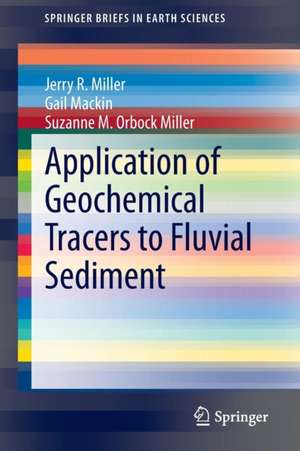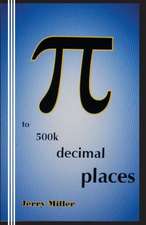Application of Geochemical Tracers to Fluvial Sediment: SpringerBriefs in Earth Sciences
Autor Jerry R. Miller, Gail Mackin, Suzanne M. Orbock Milleren Limba Engleză Paperback – 15 dec 2014
The use of environmental tracers has increased significantly during the past decade because it has become clear that documentation of sediment and sediment-associated contaminant provenance and dispersal is essential to mitigate their potentially harmful effects on aquatic ecosystems. Moreover, the use of monitoring programs to determine the source of sediments to a water body has proven to be a costly, labor intensive, long-term process with a spatial resolution that is limited by the number of monitoring sites that can be effectively maintained. Alternative approaches, including the identification and analysis of eroded upland areas and the use of distributed modeling routines also have proven problematic. The application of tracers within riverine environments has evolved such that they focus on sediments from two general sources: upland areas and specific, localized, anthropogenic point sources. Of particular importance to the former is the development of geochemicalfingerprinting methods that quantify sediment provenance (and to a much lesser degree, sediment-associated contaminants) at the catchment scale. These methods have largely developed independently of the use of tracers to document the source and dispersal pathways of contaminated particles from point-sources of anthropogenic pollution at the reach- to river corridor-scale. Future studies are likely to begin merging the strengths of both approaches while relying on multiple tracer types to address management and regulatory issues, particularly within the context of the rapidly developing field of environmental forensics.
Din seria SpringerBriefs in Earth Sciences
-
 Preț: 380.25 lei
Preț: 380.25 lei -
 Preț: 378.12 lei
Preț: 378.12 lei -
 Preț: 290.09 lei
Preț: 290.09 lei -
 Preț: 477.72 lei
Preț: 477.72 lei -
 Preț: 381.98 lei
Preț: 381.98 lei -
 Preț: 355.07 lei
Preț: 355.07 lei -
 Preț: 355.37 lei
Preț: 355.37 lei -
 Preț: 351.90 lei
Preț: 351.90 lei -
 Preț: 381.21 lei
Preț: 381.21 lei -
 Preț: 377.35 lei
Preț: 377.35 lei -
 Preț: 342.44 lei
Preț: 342.44 lei -
 Preț: 343.98 lei
Preț: 343.98 lei - 20%
 Preț: 389.08 lei
Preț: 389.08 lei -
 Preț: 378.92 lei
Preț: 378.92 lei -
 Preț: 375.62 lei
Preț: 375.62 lei -
 Preț: 379.68 lei
Preț: 379.68 lei -
 Preț: 378.12 lei
Preț: 378.12 lei -
 Preț: 377.18 lei
Preț: 377.18 lei -
 Preț: 443.75 lei
Preț: 443.75 lei -
 Preț: 378.54 lei
Preț: 378.54 lei -
 Preț: 376.96 lei
Preț: 376.96 lei -
 Preț: 379.09 lei
Preț: 379.09 lei - 15%
 Preț: 464.18 lei
Preț: 464.18 lei -
 Preț: 376.96 lei
Preț: 376.96 lei -
 Preț: 348.01 lei
Preț: 348.01 lei -
 Preț: 379.48 lei
Preț: 379.48 lei -
 Preț: 375.07 lei
Preț: 375.07 lei -
 Preț: 477.94 lei
Preț: 477.94 lei -
 Preț: 376.22 lei
Preț: 376.22 lei -
 Preț: 349.41 lei
Preț: 349.41 lei -
 Preț: 381.00 lei
Preț: 381.00 lei - 15%
 Preț: 463.35 lei
Preț: 463.35 lei -
 Preț: 376.22 lei
Preț: 376.22 lei -
 Preț: 376.96 lei
Preț: 376.96 lei -
 Preț: 446.47 lei
Preț: 446.47 lei -
 Preț: 346.62 lei
Preț: 346.62 lei -
 Preț: 379.68 lei
Preț: 379.68 lei -
 Preț: 373.32 lei
Preț: 373.32 lei -
 Preț: 377.95 lei
Preț: 377.95 lei -
 Preț: 377.57 lei
Preț: 377.57 lei -
 Preț: 390.83 lei
Preț: 390.83 lei -
 Preț: 375.45 lei
Preț: 375.45 lei -
 Preț: 377.73 lei
Preț: 377.73 lei -
 Preț: 376.04 lei
Preț: 376.04 lei -
 Preț: 377.18 lei
Preț: 377.18 lei -
 Preț: 379.09 lei
Preț: 379.09 lei
Preț: 380.07 lei
Nou
Puncte Express: 570
Preț estimativ în valută:
72.74€ • 78.52$ • 60.100£
72.74€ • 78.52$ • 60.100£
Carte tipărită la comandă
Livrare economică 19 aprilie-03 mai
Preluare comenzi: 021 569.72.76
Specificații
ISBN-13: 9783319132204
ISBN-10: 3319132202
Pagini: 142
Ilustrații: X, 142 p. 40 illus. in color.
Dimensiuni: 155 x 235 x 10 mm
Greutate: 0.23 kg
Ediția:2015
Editura: Springer International Publishing
Colecția Springer
Seria SpringerBriefs in Earth Sciences
Locul publicării:Cham, Switzerland
ISBN-10: 3319132202
Pagini: 142
Ilustrații: X, 142 p. 40 illus. in color.
Dimensiuni: 155 x 235 x 10 mm
Greutate: 0.23 kg
Ediția:2015
Editura: Springer International Publishing
Colecția Springer
Seria SpringerBriefs in Earth Sciences
Locul publicării:Cham, Switzerland
Public țintă
ResearchCuprins
Introduction.- Geochemical Fingerprinting.- Fallout Radionuclides.- Radiogenic Isotopes.- Stable ‘Non-Traditional’ Isotopes.- Abbreviations, Unit Conversions, and Elemental Data.
Caracteristici
Includes supplementary material: sn.pub/extras










